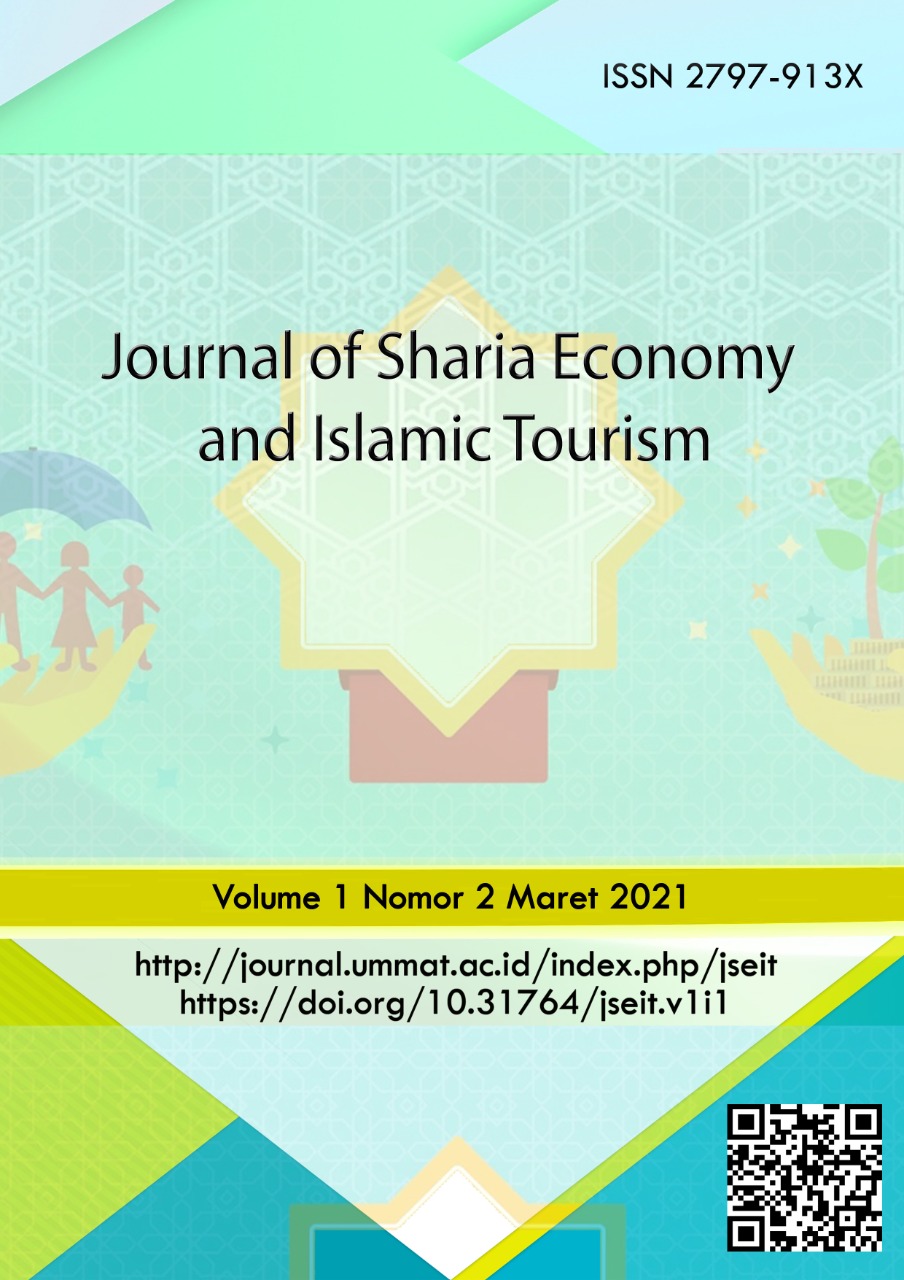Exploitation Of Sabbe Sarong In West Nusa Tenggara In Triggering The Economy During The Pandemic
DOI:
https://doi.org/10.31764/jseit.v1i2.8281Keywords:
Sabbe Sarong, Economic, PendemiAbstract
Abstract: Sabbe sarong is a typical weaving of bugis tribe that has long lived and developed until it is known as a typical handicraft of Tanjung Luar. Because it has been attached and become their trademark, usually this sarong is used instead of a hood. Which, they usually make this sarong in their spare time while waiting for their husbands to go back to sea. However, after this pandemic comes will certainly have an impact on the main livelihood of the people of Tanjung Luar as a fisherman. Therefore, if an action is taken that will have a positive impact on human resources and the region, it will definitely benefit all parties. Therefore, the role of Sabbe Sarong needs to be developed so that regional MSMEs can be applied even in this Pandemic condition. The purpose of this study is to examine more deeply about the exploitation of sabbe holsters in West Lombok so as to improve the economy of the people of the pendemi period, with the method used is qualitative method.
Abstrak: Sarung Sabbe merupakan tenunan khas suku bugis yang telah lama hidup dan berkembang hingga dikenal sebagai kerajinan khas Tanjung Luar. Karena telah melekat dan menjadi ciri khas mereka, biasanya sarung ini digunakan sebagai pengganti tudung kepala.Yang mana, mereka biasanya membuat sarung ini di waktu senggang sambil menunggu suami mereka balik melaut. Akan tetapi, setelah pandemi ini datang tentu akan berdampak pada mata pencaharian utama penduduk Tanjung Luar sebagai seorang Nelayan. Untuk itu, jika dilakukan suatu tindakan yang akan berdampak positif terhadap Sumber Daya Manusia dan daerah, pasti akan menguntungkan segala pihak. Oleh sebab itu, peranan Sarung Sabbe ini perlu dikembangkan sehingga  UMKM  daerah  dapat  terapkan  walaupun  dalam  kondisi Pandemi ini. Tujuan dari penelitian ini adalah untuk mengkaji lebihÂ
Abstract: Sabbe sarong is a typical weaving of bugis tribe that has long lived and developed until it is known as a typical handicraft of Tanjung Luar. Because it has been attached and become their trademark, usually this sarong is used instead of a hood. Which, they usually make this sarong in their spare time while waiting for their husbands to go back to sea. However, after this pandemic comes will certainly have an impact on the main livelihood of the people of Tanjung Luar as a fisherman. Therefore, if an action is taken that will have a positive impact on human resources and the region, it will definitely benefit all parties. Therefore, the role of Sabbe Sarong needs to be developed so that regional MSMEs can be applied even in this Pandemic condition. The purpose of this study is to examine more deeply about the exploitation of sabbe holsters in West Lombok so as to improve the economy of the people of the pendemi period, with the method used is qualitative method.
Abstrak: Sarung Sabbe merupakan tenunan khas suku bugis yang telah lama hidup dan berkembang hingga dikenal sebagai kerajinan khas Tanjung Luar. Karena telah melekat dan menjadi ciri khas mereka, biasanya sarung ini digunakan sebagai pengganti tudung kepala.Yang mana, mereka biasanya membuat sarung ini di waktu senggang sambil menunggu suami mereka balik melaut. Akan tetapi, setelah pandemi ini datang tentu akan berdampak pada mata pencaharian utama penduduk Tanjung Luar sebagai seorang Nelayan. Untuk itu, jika dilakukan suatu tindakan yang akan berdampak positif terhadap Sumber Daya Manusia dan daerah, pasti akan menguntungkan segala pihak. Oleh sebab itu, peranan Sarung Sabbe ini perlu dikembangkan sehingga  UMKM  daerah  dapat  terapkan  walaupun  dalam  kondisi Pandemi ini. Tujuan dari penelitian ini adalah untuk mengkaji lebih
References
Awwabin, Salma (2021), “Metode Penelitian Kualitatifâ€, tersedia di https://penerbitdeepublish.com/metode-penelitian-kualitatif/, diakses pada 06 Juli 2021,Pukul 11.13 WITA.
Fadli, Ahmad (2021), “Dampak Pandemi Covid-19 Terhadap Pendapatan Umkm Di Desa Gondang Kecamatan Gangga Kabupaten Lombok Utaraâ€, Tersedia di file:///C:/Users/ACER%20-%20AC/Downloads/Documents/COVER- BAB%20III_2.pdf, diakses pada 07 Juli 2021, Pukul 21.49 WITA.
Kompasiana (2015), “Keahliana, pengetahuan dan bakatâ€,Tersedia di https://www.kompasiana.com/ilham.permadi/550061c3a333117f73510b4a/keahlian- pengetahuan-dan-bakat, diakses pada 15 Juli 2021, pada pukul 08.20 WITA.
NTB , Diskominpotik. 2021. “Gubernur Dr. Zul membangun industrialisasi di tengah pandemiâ€, https://www.ntbprov.go.id/post/program-unggulan/gubernur-dr-zul- membangun-industrialisasi-di-tengah-pandemi-covid-19, diakses pada 26 Mei 2021
pukul 20.20 WITA.
Today , Lombok (2020), “tak temukan wajah tanjung luar tempo doeloe†Tersedia di https://lomboktoday.co.id/2020/09/24/tak-temukan-wajah-tanjung-luar-tempo-doeloe- wisatawan-kecewa-1305.html, diakses pada 16 Juni 2021 pukul 20.40 WITA.
Unairnews (2021), “Dampak pandemi covid 19 pada sektor perikanan nasionalâ€,Tersedia di http://news.unair.ac.id/2021/07/01/dampak-pandemi-covid-19-pada-sektor-perikanan- nasional/, diakses pada 15 Juli 2021, pukul 08.46 WITA.
Wisata Indonesia, GPS (2020) “Kain Tenun Lipa Sabbe Sulawesi Selatanâ€, Tersedia di https://gpswisataindonesia.info/kain-tenun-lipa-sabbe-sulawesi-selatan/, diakses pada 07 Juli 2021, Pukul 21.33 WITA.
Downloads
Published
Issue
Section
License
Authors who publish articles in Journal of Sharia Economy and Islamic Tourism agree to the following terms:
- Authors retain copyright of the article and grant the journal right of first publication with the work simultaneously licensed under a CC-BY-SA or The Creative Commons Attribution–ShareAlike License.
- Authors are able to enter into separate, additional contractual arrangements for the non-exclusive distribution of the journal's published version of the work (e.g., post it to an institutional repository or publish it in a book), with an acknowledgment of its initial publication in this journal.
- Authors are permitted and encouraged to post their work online (e.g., in institutional repositories or on their website) prior to and during the submission process, as it can lead to productive exchanges, as well as earlier and greater citation of published work (See The Effect of Open Access).

